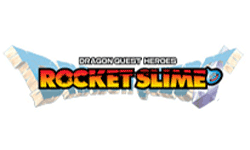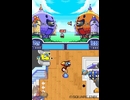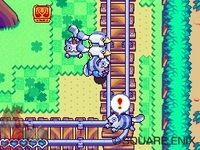|
|

|
PLATFORM
|
DS
|
BATTLE SYSTEM
|

|
INTERACTION
|

|
ORIGINALITY
|

|
STORY
|

|
MUSIC & SOUND
|

|
VISUALS
|

|
CHALLENGE
|
Very Easy
|
COMPLETION TIME
|
Less than 20 Hours
|
|
OVERALL

|
+ Cute slime livelihood
+ Nifty tank battles
+ Puns at the drop of a slime
- Ends fast
|
Click here for scoring definitions
|
|
|
The early years of the DS were truly a great time for games to cross the Pacific. Companies searched avidly for anything to provide as product for store shelves, and without that dogged determination by Square Enix to have something new on the shelves, Dragon Quest Heroes: Rocket Slime probably wouldn't have gotten a localization. DS owners who have played the game are happy it somehow made the grade, because this is a delightful little title that shows a different side of the standard Dragon Quest slime, and in a better way than its Japan-only predecessor to boot.
Rocket Slime's plot is more of a reboot to Slime Morimori than a sequel, finding a town called Boingburg with 100 slime inhabitants being menaced by the not-very-menacing Plob. A player-named slime is the only one to survive the Plob's kidnapping assault, and is tasked with rescuing everyone. Aside from a rival slime assisting the Plob when it suits his purposes, the overall plot is pretty much the same as in Slime Morimori, but that is not inherently a negative, particularly when the execution is so entertainingly frothy.
In particular, Square Enix's localization adds a great deal of flavor to the game. The pun is a frequently-maligned mechanism, but its lighthearted attitude and silly presentation make the approach completely appropriate. Rocket Slime is filled with puns, and while they individually may not be anything approaching great humor, their cumulative effect wears down resistance until the player is ready to find something like Don Clawleone far more amusing than it would be elsewhere. The story isn't much in synopsis form, and certainly isn't going to win prizes based on its amazingly detailed character development and sophisticated story structure, but is quite entertaining nevertheless.
The player-controlled slime's task is to bring all the incapacitated residents of Boingburg home, which he will accomplish by bouncing them into the air and setting them onto a plentiful number of rail cars that go exactly where they need to. Most of them are depressingly immobile when freed from imprisoning chests, but this slime is capable of holding things on its head even without a central skeletal structure. This is done by bouncing into them using the Elasto Blast, taking advantage of the slime's pliability to stretch out and spring into anything in the way. Enemies will be hurt by this, while anything else will simply be launched into the air, from which point the slime can get underneath and cart it around. A welcome improvement over Slime Morimori is the DS's additional face input, which allow Elasto Blasts and tossing things off the slime not to be used with the same button.
 These large mechanical constructs tank you very much.
These large mechanical constructs tank you very much.
|
|
While beating up the enemies with the Elasto Blast is perfectly doable, it's often faster to toss them onto a rail cart and send them to Boingburg, a perfectly acceptable tactic. The slime's health bar grows throughout the game, and his ability to take plenty of hits along with frequent health replenishment means defeat is extremely unlikely. Exploring the environments is entertaining even without fear of defeat, and the game goes by quickly and smoothly in less than ten hours.
What distinguishes Rocket Slime from its GBA predecessor, and gives it a certain addictive quality, is tank combat. The heroic slime quickly gains a tank in his own image and puts it to work against similarly silly mechanical masterpieces. These tank fights play in a completely different manner from the rest of the game, and are quite welcome in their frequent appearances as a means of keeping variety in the gameplay. They also give a reason to send as much stuff back to town as possible, because it is from this stockpile that the tank's ammunition is taken.
The goal of every tank encounter is to reduce the opponent's HP to zero, after which the heroic slime must enter the vehicle and smash his way into its engine for the coup de grâce. Initially the slime is alone in this endeavor, but quickly gains the ability to put three of the Boingburg residents into his crew for assistance. Directly harming the enemy tank is the job of two cannons on the hero's own armor, which spew forth a wide variety of armaments manually loaded from chutes around the vehicle that constantly disgorge fresh ammo. The enemy is doing the same, and sometimes its crew members will attempt to infiltrate the hero's tank in order to disrupt its operations. The resulting fracases are quite involving and entertaining, as they require the player to constantly stay on the move around the tank's interior to toss munitions around and repel unfriendly visitors. Rocket Slime's tank battles deliver a pleasant variety of opponents and a very investing means of sending them down in flames. Optional tank battles are present to entice extra playing time, and their entertainment value is sufficient to make this an appealing prospect.
 Going off the rails makes for a sourpuss.
Going off the rails makes for a sourpuss.
|
|
Aside from keeping the Dragon Quest mechanic of losing half the current cash upon defeat, Rocket Slime is more an overhead platformer than an RPG. The heroic slime can amass money and increase his life force, along with paying to upgrade the tank's HP by a considerable margin. Otherwise it's not even close to the same type of game as the series from which it spawned. This is hardly a glaring problem, since the speed with which the game plays would not have fit into the template of a turn-based RPG. It merely differentiates Rocket Slime in a handy way from the ranks of Dragon Quest's many other permutations.
Plenty of familiar sound effects and music cues are scattered throughout Rocket Slime. They don't provide a consistently beguiling audio backdrop, and indeed the game could use a few more compositions for variety's sake, yet the audio is pleasant enough to make experiencing it agreeable. The visuals aren't impressive from a technical standpoint, but exude cheerful sprite work at all times. The improvement over the original Slime Morimori is incremental but undeniable, and the menagerie of slime types has been increased even more to fill Boingburg with residents who are not lookalikes.
Rocket Slime is a quick blast to play. It won't stimulate new regions of the brain or cause meaningful dialogue to erupt between hostile camps, but it delivers a fun time on the DS screens. Its 3DS successor seems unlikely to cross the Pacific, an unfortunate state of affairs. At least this game exists to make clear how much room for experimenting the Dragon Quest universe allows, and how fruitful such adventures can be.
Review Archives
|









